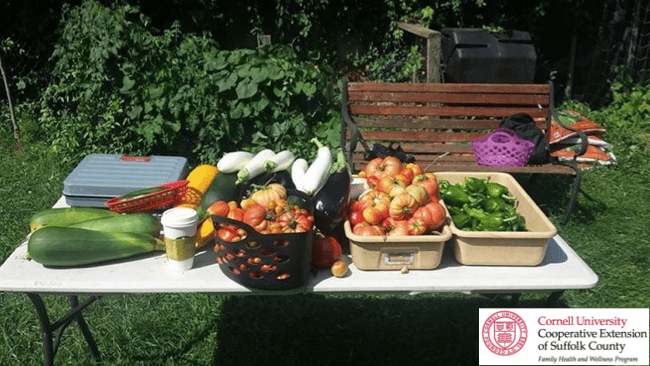By Elizabeth Takakjian
Vine ripe tomatoes are one of the vegetables most gardeners think of as the iconic vegetable – fruit of summer. Picking cherry tomatoes by the handful or that plump slicing tomato as it ripens to that perfect red or golden yellow is worth the wait. My favorites, black cherries, ripen to a purplish brown. In a dry spell, avoid those unsightly black bottoms, aka Blossom End Rot, by keeping your tomato plants evenly watered. But don’t let the one that’s just about ready stay on the vine if a heavy rain is predicted; harvest it and let it ripen on your window sill. If you leave it on the vine as the plant takes up all that water it’s likely to spit the skin of what would have been a perfect tomato.
Or it could be that corn is your summer favorite. Knowing when to harvest corn can be a little tricky because you have to wait until the ear looks full and the silks turn brown and dry. To test if it’s ready, pull back the one corner of the leaves just until you can reach plump kernel, puncture it with your thumbnail. If the liquid is clear, then the corn is immature; give it another day or two until the liquid is milky for perfect corn.
The other iconic garden vegetable is the biggest fruit from the garden…it might be a two pound tomato, but it just could be that huge baseball bat zucchini or the humungous melon you let grow until you just had to know how heavy it was. And it is fun to peel and chop that zucchini and serve up at a family gathering, where you can share, “Can you believe that whole dish came from one of my zucchinis!”
In general regular harvesting encourages your plants to produce more abundantly. So harvest often, if not daily then at least two or three times a week. Leaves of chard, mesclun and other greens are more tender when harvested young. So snip off the largest outer leaves and enjoy, the plant will keep producing. Harvesting the entire head of lettuce makes room for succession planting, put in some new seeds and you’ll have a new fresh crop to harvest later in the season.
Small cucumbers have small seeds and are great with cherry tomatoes. I add a little parsley, lemon juice and a bit of olive oil and a dash of paprika for a refreshing summer salad. To harvest summer squashes, hold the fruit firmly near the stem and twist slowly; it should break off easily. To harvest pepper, eggplant, and winter squashes, I use clippers.
Almost anything from your garden can be grilled; peppers, eggplants, carrots, fennel, butternut squash, the list goes on. Medium sized zucchini and summer squash are great for grilling; try cutting them about ¼” to ½” thick in long strips or on the diagonal, bushing with a little oil flavored with some freshly cut herbs. Baking stuffed veggies is another great way to enjoy your summer produce. Huge zucchini have big seeds; scoop them out and fill with a chopped and sautéed veggie medley and pop in the oven to bake for a delicious treat. Pies and tarts can be sweet or savory; watermelon can be enjoyed as a summer salad, just cube some up, add silvered red onion, chopped mint and a sprinkle of goat or feta cheese for something refreshing to go with your next BBQ. If you are shopping for the perfect watermelon, pick it up and snap you finger against it, if you hear a hollow thunk noise it’s ready; from the garden, wait until the stem withers on the vine before clipping the stem for the sweetest melon.
When you garden is in full swing, you’ll have more produce than you’ll be able to consume. What do you do with it all? Share it with a friend or a local food pantry. Let your children set up a farm stand. Can it. Pickle it. Opening a jar of tomatoes or pickles in January is like a burst of flavor from your summer garden. Classes for food preservation may be offered by your local library or the local county extension office in your area.
Elizabeth Takakjian is a Program Educator with Cornell Cooperative Extension of Suffolk County’s Family Health and Wellness Program, as well as a Master Gardener.
